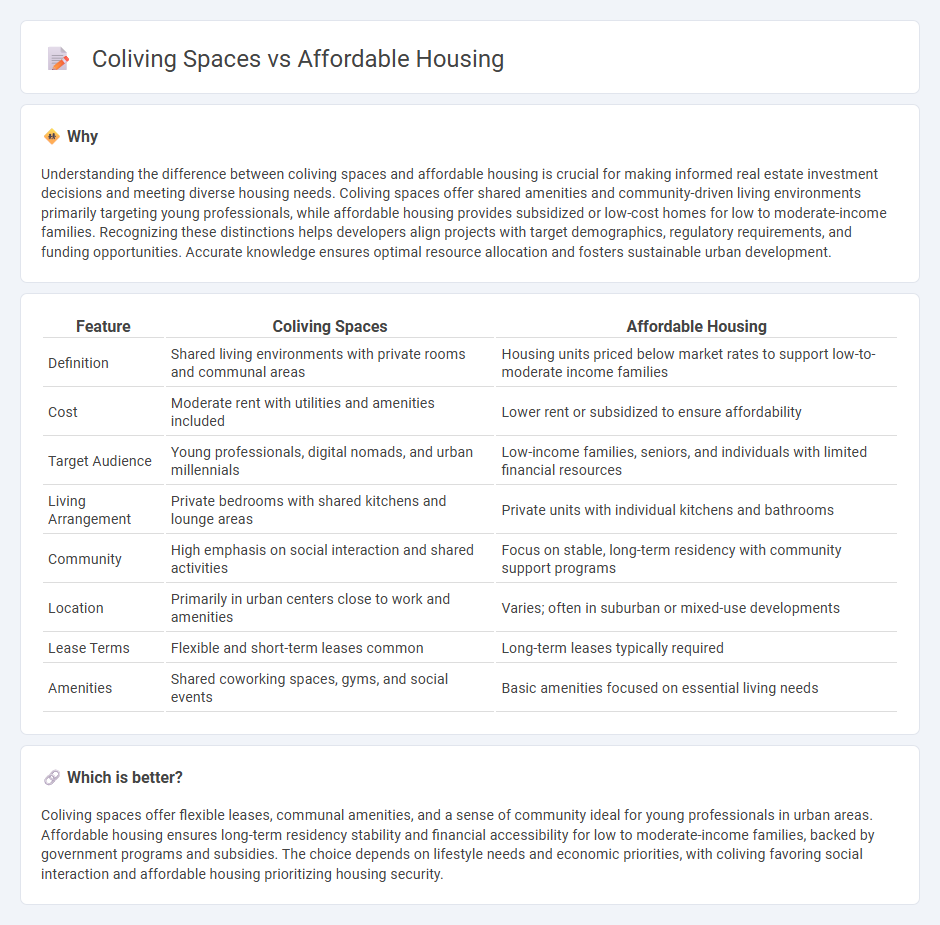
Coliving spaces offer a modern solution for urban dwellers seeking community-focused living with shared amenities, often located in prime city areas, while affordable housing targets low-income families by providing cost-effective, government-subsidized units designed to ensure long-term stability. Real estate developers balance maximizing space efficiency and affordability to meet diverse market demands, integrating smart design and sustainability features. Discover how these housing models reshape urban real estate landscapes and address evolving residential needs.
Why it is important
Understanding the difference between coliving spaces and affordable housing is crucial for making informed real estate investment decisions and meeting diverse housing needs. Coliving spaces offer shared amenities and community-driven living environments primarily targeting young professionals, while affordable housing provides subsidized or low-cost homes for low to moderate-income families. Recognizing these distinctions helps developers align projects with target demographics, regulatory requirements, and funding opportunities. Accurate knowledge ensures optimal resource allocation and fosters sustainable urban development.
Comparison Table
| Feature | Coliving Spaces | Affordable Housing |
|---|---|---|
| Definition | Shared living environments with private rooms and communal areas | Housing units priced below market rates to support low-to-moderate income families |
| Cost | Moderate rent with utilities and amenities included | Lower rent or subsidized to ensure affordability |
| Target Audience | Young professionals, digital nomads, and urban millennials | Low-income families, seniors, and individuals with limited financial resources |
| Living Arrangement | Private bedrooms with shared kitchens and lounge areas | Private units with individual kitchens and bathrooms |
| Community | High emphasis on social interaction and shared activities | Focus on stable, long-term residency with community support programs |
| Location | Primarily in urban centers close to work and amenities | Varies; often in suburban or mixed-use developments |
| Lease Terms | Flexible and short-term leases common | Long-term leases typically required |
| Amenities | Shared coworking spaces, gyms, and social events | Basic amenities focused on essential living needs |
Which is better?
Coliving spaces offer flexible leases, communal amenities, and a sense of community ideal for young professionals in urban areas. Affordable housing ensures long-term residency stability and financial accessibility for low to moderate-income families, backed by government programs and subsidies. The choice depends on lifestyle needs and economic priorities, with coliving favoring social interaction and affordable housing prioritizing housing security.
Connection
Coliving spaces and affordable housing both address urban housing shortages by maximizing space efficiency and reducing individual costs through shared amenities and communal living. These models leverage affordable rent structures and flexible lease terms to attract young professionals and low-income residents, promoting social interaction and economic diversity. Integrating coliving designs within affordable housing projects enhances community engagement while providing cost-effective urban living solutions.
Key Terms
Rent Control
Rent control policies aim to keep housing costs stable by limiting rent increases, benefiting affordable housing tenants who typically have long-term leases. Coliving spaces often operate under flexible lease terms and market-driven rents, making them less impacted by traditional rent control measures. Explore how these differences affect housing affordability and tenant stability in evolving urban markets.
Shared Amenities
Affordable housing often features basic shared amenities such as laundry facilities and common outdoor areas designed to reduce living costs. Coliving spaces prioritize premium shared amenities, including coworking zones, community kitchens, and wellness centers, fostering social interaction and convenience. Explore the benefits and differences of shared amenities in affordable housing and coliving spaces to find the best fit for your lifestyle.
Income Eligibility
Income eligibility criteria for affordable housing typically target low- to moderate-income households based on area median income (AMI) thresholds determined by local housing authorities. Coliving spaces often offer flexible income requirements, appealing to young professionals and digital nomads seeking cost-effective urban living without stringent eligibility verification. Explore how income eligibility impacts your housing options and discover which solution aligns with your financial situation.
Source and External Links
Housing Programs - Fort Worth Housing Solutions - Provides a variety of affordable housing options through mixed-income rental and homeownership opportunities for income-eligible residents earning 80% or less of the Area Median Income, including rehabilitation and new construction projects.
Housing Assistance Office - Tarrant County - Offers safe, decent, and affordable housing assistance targeted at extremely low to low income families, supporting upward mobility and compliance with Fair Housing laws.
Low Income Housing Tarrant County - Samaritan House - Provides affordable and supportive housing to individuals and families at or below the poverty level, including locations with amenities like appliances and all-bills-paid in Fort Worth's Medical District.
 dowidth.com
dowidth.com